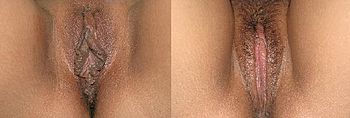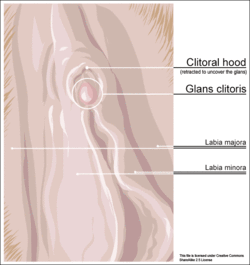- Clitoral hood reduction
-
Clitoral hood reduction is an elective plastic surgery procedure for reducing the size and the area of the clitoral prepuce in order to further expose the clitoris; the therapeutic goal is to improve the sexual functioning of the woman, and the aesthetic refinement of her pudendum femininum (vulva). The reduction of the clitoral prepuce tissues usually is a sub-ordinate surgery within a labiaplasty procedure for reducing the labia minora; and occasionally within a vaginoplasty procedure.
Contents
Surgical procedures
The procedures for labiaplasty occasionally include a clitoral hood reduction.[1] One technique for reducing the clitoral hood is the bilateral excision (cutting) of the prepuce tissues covering the clitoris, with especial attention to maintaining the clitoris in the midline.[2] Another technique cuts away (excises) the redundant folds of clitoral prepuce tissue, with incisions parallel to the long axis of the clitoris.[3]
Clitoral hood reduction is included to the wedge resection labiaplasty technique, wherein the extension of the exterior wedge sections is applied to reducing the prepuce tissues of the clitoris. Yet, occasionally excess prepuce-skin, in the center of the clitoral hood, is removed with separate incisions.[4]
Results
The functional corrections and aesthetic improvements to the vulvo-vaginal complex indicate that labiaplasty procedures have a high-rate of patient satisfaction with the surgical outcome, and a low incidence-rate of medical complications.[5][6][7][8] The study Aesthetic Labia Minora and Clitoral Hood Reduction using Extended Central Wedge Resection (2008) reported that of a 407-woman cohort, 98 per cent were satisfied with the labial reduction outcomes; that the average patient satisfaction score was 9.2 points on a 10-point scale; that 95 per cent of the women experienced reduced pudendal discomfort; that 93 per cent of the women experienced improved self esteem; that 71 per cent experienced improved sexual functioning; that 0.6 per cent (one woman) reported lessened sexual functioning; and that 4.4 per cent of the women experienced medical complications.[9]
Moreover, regarding the woman’s satisfaction with the plastic surgical outcome, the study Expectations and Experience of Labial Reduction: A Qualitative Study (2007) reported that the women who underwent labiaplasty had great expectations for the elimination of pubic discomfort and pain, improved cosmetic appearance of the pudendum femininum, and improved sexual functioning. Most of the women experienced improved self esteem; yet the study also reported that formal psychological counselling before the surgical operation, about what to expect and what not to expect from a labia minora and a clitoral prepuce reduction procedure, might better serve the woman (as the patient) by assisting her in establishing realistic (feasible) goals for her genital beauty and mental health, which might be derived from a genitoplastic procedure.[10][11]
Criticism
The American College of Obstetricians and Gynecologists (ACOG) published Committee Opinion No. 378: Vaginal “Rejuvenation” and Cosmetic Vaginal Procedures (2007), the college’s formal policy statement of opposition to the commercial misrepresentations of labiaplasty, and associated vaginoplastic procedures, as medically “accepted and routine surgical practices”. The ACOG doubted the medical safety and the therapeutic efficacy of the surgical techniques and procedures for performing vaginoplastic operations such as labiaplasty, vaginal rejuvenation, the designer vagina, revirgination, and Gräfenberg Spot amplification, and recommended that women seeking such genitoplastic surgeries must be fully informed, with the available surgical-safety statistics, of the potential health risks of surgical-wound infection, of pudendal nerve damage (resulting in either an insensitive or an over-sensitive vulva), of dyspareunia (painful coitus), of tissue adhesions (epidermoid cysts), and of painful scars.[12]
To determine whether or not women truly seek labiaplasty solely to have “more socially acceptable genitalia” the International Society for the Study of Women’s Sexual Health (ISSWSH) considered the practices of elective plastic surgery of the vulva and of FGC (female genital cutting) in the Third World. The report, Is Elective Vulvar Plastic Surgery ever Warranted and What Screening Should be Done Preoperatively? (2007) indicated that physical variations in the external appearance of the vulvo-vaginal complex are statistically normal, but that labiaplasty — like access to all types of medical treatment — is a woman’s human right. Nonetheless, the ISSWSH report concluded that vaginoplastic surgery might be medically warranted only after the woman undergoes a pre-operative psychological screening, and only if the woman afterwards remains so decided — yet also recommended that the vaginal surgery can be performed if the surgeon deems it medically necessary for her health.[13]
References
- ^ Mirzabeigi MN, Moore JH Jr, Mericli AF, Bucciarelli P, Jandali S, Valerio IL, Stofman GM. Current Trends in Vaginal Labioplasty: A Survey of Plastic Surgeons. Annals of Plastic Surgery. 2011 PMID 21346521
- ^ Felicio Y. Labial Surgery. Aesthetic Surgery Journal. 2007. 27:3;322–328.
- ^ Hunter JG. Considerations in Female External Genital Aesthetic Surgery Techniques. Aesthetic Surgery Journal. 2008. 28:1;106–107.
- ^ Alter GJ. Aesthetic Labia Minora and Clitoral Hood Reduction Using Extended Central Wedge Resection. Plastic and Reconstructive Surgery. 2008. 122:6; 1780–1789.
- ^ Felicio Y. Labial Surgery. Aesthetic Surgery Journal. 2007. 27:3;322–328.
- ^ Alter GJ. Aesthetic Labia Minora and Clitoral Hood Reduction Using Extended Central Wedge Resection. Plastic and Reconstructive Surgery. 2008. 122:6; 1780–1789.
- ^ Scholten E. Female Genital Cosmetic Surgery — The Future. Journal of Plastic, Reconstructive & Aesthetic Surgery. doi:10.1016/j.bps.2009.01.002.
- ^ Mirzabeigi MN, Moore JH, Mericli AF, Bucciarelli P, Jandali S, Valerio IL, Stofman GM. Current Trends in Vaginal Labioplasty: A Survey of Plastic Surgeons. Annals of Plastic Surgery. 2011. PMID 21346521
- ^ Alter GJ. Aesthetic Labia Minora and Clitoral Hood Reduction Using Extended Central Wedge Resection. Plastic and Reconstructive Surgery. 2008. 122:6; 1780–1789.
- ^ Bramwell R, Morland C, Garden AS. Expectations and Experience of Labial Reduction: A Qualitative Study. British Journal of Obstetrics and Gynaecology. 2007. 114(12);1493–1499.
- ^ Di Saia JP. An Unusual Staged Labial Rejuvenation. Journal of Sexual Medicine. 2008:5;1263–1267.
- ^ American College of Obstetricians and Gynecologists (2007) (PDF). Vaginal "Rejuvenation" and Cosmetic Vaginal Procedures. p. 2. http://www.newviewcampaign.org/userfiles/file/ACOG%20gen.cosm.surg.pdf.
- ^ Goodman MP, Bachmann G, Johnson C, Fourcroyo JL, Goldstein A, Goldstein G, Sklar S. Is Elective Vulvar Plastic Surgery ever Warranted and What Screening Should be Done Preoperatively? Journal of Sexual Medicine 2007;4:269–276
External resources
Categories:- Genital modification
- Plastic surgery
- Surgical removal procedures
Wikimedia Foundation. 2010.


